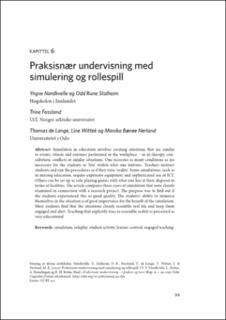Praksisnær undervisning med simulering og rollespill
Nordkvelle, Yngve Troye; Stalheim, Odd Rune; Fossland, Trine; de Lange, Thomas; Wittek, Anne Line; Nerland, Monika Bærøe
Chapter
Published version
Permanent lenke
https://hdl.handle.net/11250/2725728Utgivelsesdato
2020Metadata
Vis full innførselSamlinger
Originalversjon
https://doi.org/10.23865/noasp.94.ch6Sammendrag
Simulation in education involves creating situations that are similar to events, rituals and routines performed in the workplace – or in therapy, consultation, conflicts or similar situations. One recreates as many conditions as are necessary for the students to ‘live’ within what one imitates. Teachers instruct students and run the procedures as if they were ‘reality’. Some simulations, such as in nursing education, require expensive equipment and sophisticated use of ICT. Others can be set up as role-playing games with what one has at their disposal in terms of facilities. The article compares three cases of simulation that were closely examined in connection with a research project. The purpose was to find out if the students experienced this as good quality. The students’ ability to immerse themselves in the situation is of great importance for the benefit of the simulation. Most students find that the situations closely resemble real life and keep them engaged and alert. Teaching that explicitly tries to resemble reality is perceived as very educational.

